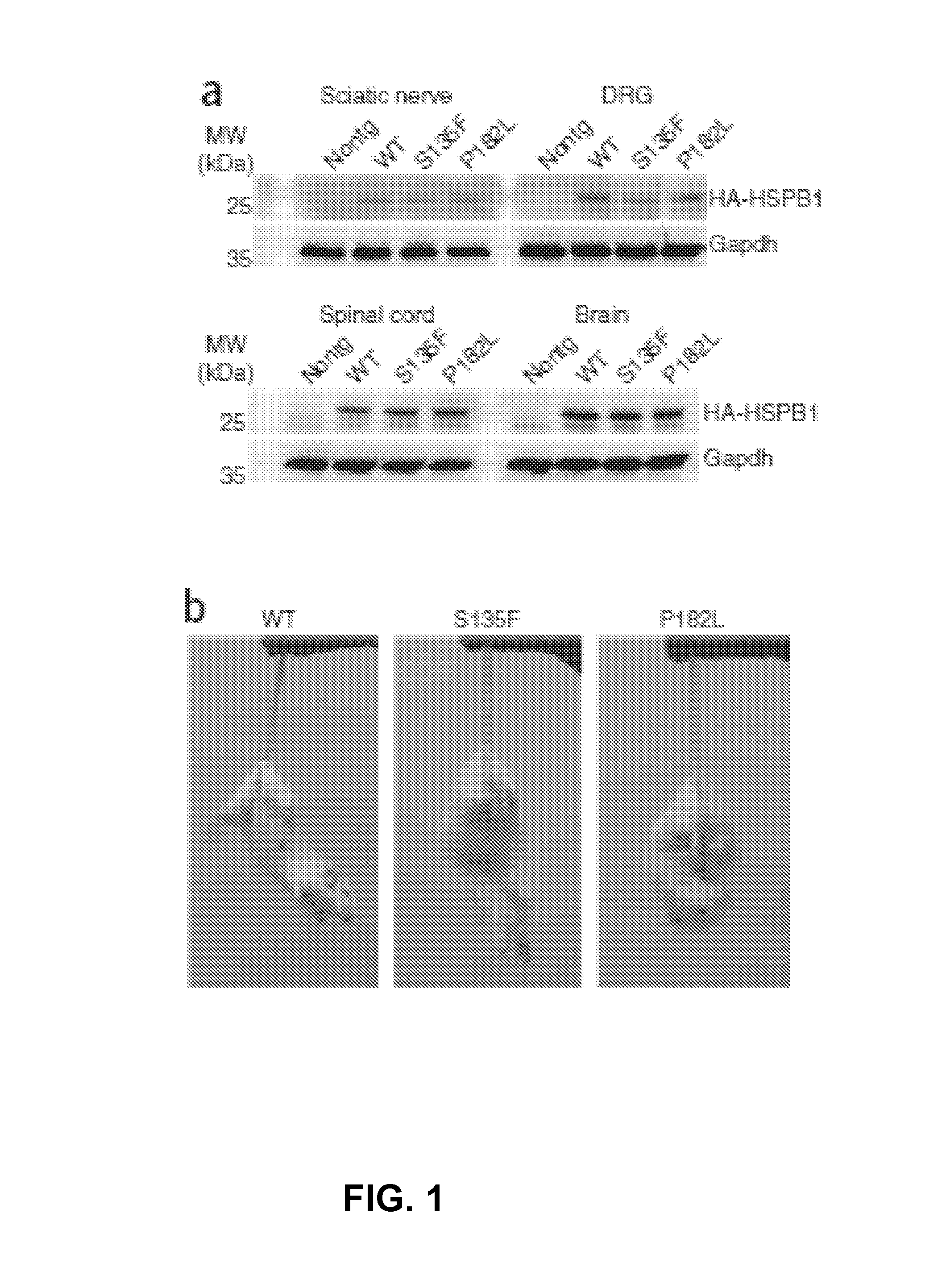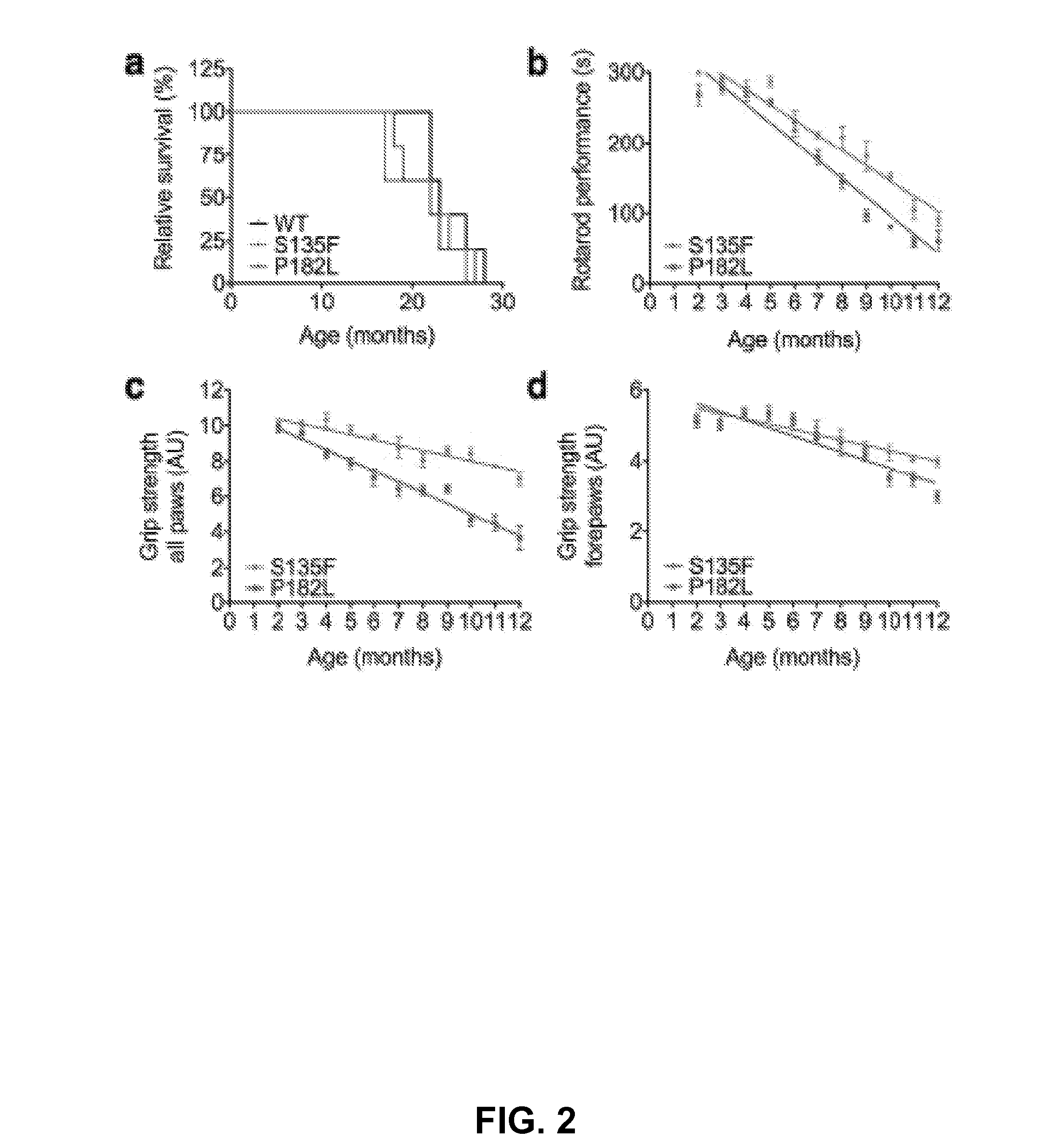HDAC inhibitors to treat charcot-marie-tooth disease
a technology of hdac inhibitors and charcotmarie teeth, which is applied in the field of peripheral nervous system diseases, can solve the problems of severe axonal transport deficits and decreases in acetylated -tubulin levels, and achieves the effects of reducing acetylated -tubulin levels, and reducing the phenotype of cm
- Summary
- Abstract
- Description
- Claims
- Application Information
AI Technical Summary
Benefits of technology
Problems solved by technology
Method used
Image
Examples
example 1
Mutant HSPB1 Mice Show Progressive Motor Deficits Propagating from Hind Limbs to Forelimbs
[0052]Transgenic mice were created using a Thy1.2 expression cassette responsible for postnatal and neuron-specific expression of the transgene. The human wild-type (WT) or mutant (S135F and P182L) HSPB1 cDNA coupled to an N-terminal hemagglutinin (HA)-tag were cloned in this construct and transgenic animals were made using zygote injection. Western blot analysis revealed no human HSPB1 expression in non-neuronal tissues such as heart, liver and kidney (not shown). Brain, spinal cord, DRG and peripheral nerve expressed HA-tagged human HSPB1 (FIG. 1, Panel a). No significant differences in expression levels of HSPB1 were observed between the different transgenic mice (not shown).
[0053]In transgenic mice, human WT or mutant HSPB1 was present only in the grey matter and in extended processes in the white matter (not shown). At the cellular level, HSPB1 co-localized with the neuronal marker SMI-32 ...
example 2
Mutant HSPB1 Mice Demonstrate Steppage Gait
[0057]It was observed that the mutant HSPB1 mice placed their paws in an anomalous manner on the rotating rod. In order to quantify this difference, the gait pattern was monitored using the semi-automated Catwalk™ system as described before.14,15 From six months on, both mutant HSPB1 lines needed, on average, twice the number of step cycles to cross a 40-cm long walkway compared to HSPB1WT (FIG. 3, Panel a). This resulted in a 50% reduction of the stride length (PP182L than in those expressing HSPB1S135F and were not observed in mice expressing HSPB1WT or non-transgenic mice. These data clearly demonstrate that mutant HSPB1 mice accurately mimic the steppage gait and foot deformities (such as pes cavus) observed in CMT2 and distal HMN patients.
example 3
Mutation-Dependent Sensory Deficits in Mutant HSPB1 Mice
[0058]Clinically, the P182L mutation in HSPB1 is associated with a pure motor neuropathy, while patients carrying the S135F mutation can also have sensory deficits, in particular, for pain and temperature.1,2 Therefore, tests were performed to see whether HSPB1S135F and HSPB1P182L mice showed signs of sensory impairment using the hotplate test. HSPB1S135F mice demonstrated increased response latencies compared to HSPB1WT mice getting more aggravated with age (P=0.01; FIG. 4, Panel a). In contrast, HSPB1P182L did not show any differences in response latencies compared to HSPB1WT mice (FIG. 4, Panel a), indicating that HSPB1P182L mice have only impaired motor performance while the HSPB1S135F mice have both motor and sensory deficits.
PUM
| Property | Measurement | Unit |
|---|---|---|
| thick | aaaaa | aaaaa |
| time | aaaaa | aaaaa |
| axonal transport defects | aaaaa | aaaaa |
Abstract
Description
Claims
Application Information
 Login to View More
Login to View More - R&D Engineer
- R&D Manager
- IP Professional
- Industry Leading Data Capabilities
- Powerful AI technology
- Patent DNA Extraction
Browse by: Latest US Patents, China's latest patents, Technical Efficacy Thesaurus, Application Domain, Technology Topic, Popular Technical Reports.
© 2024 PatSnap. All rights reserved.Legal|Privacy policy|Modern Slavery Act Transparency Statement|Sitemap|About US| Contact US: help@patsnap.com










